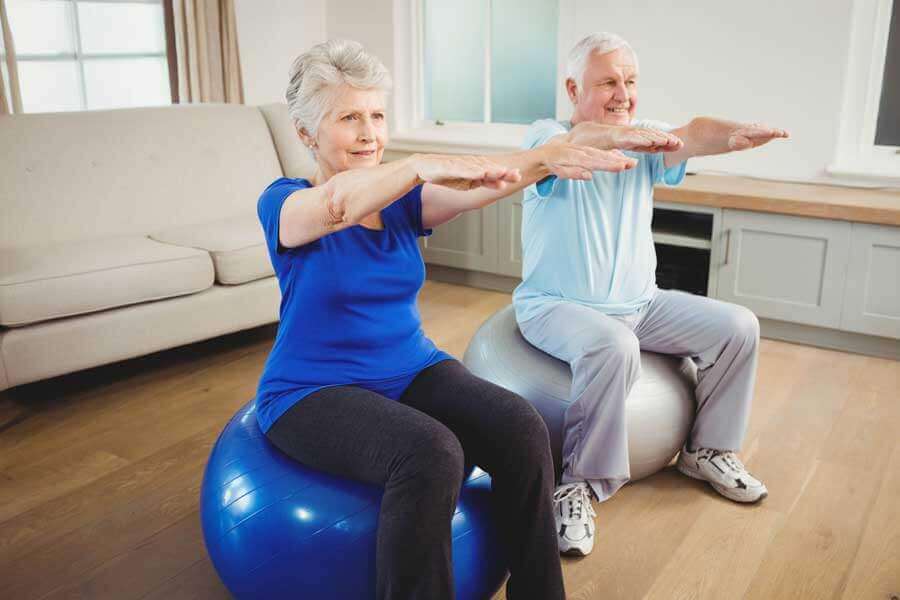5 Simple Hip Exercises to Help in Old Age

As we grow older, it’s important to recognise that we must look after our bodies and any ‘problem areas’ that cause us discomfort, now or potentially in the future. Identifying these areas and making sure to look after them is the best way to maintain mobility and flexibility. In this article we focus on our hips, working on exercises which can maintain flexibility and alleviate pain, helping you to avoid hip deterioration and also improve your balance - all crucial ways to maintain your physical health and comfort!
Always speak to your physician before beginning a new exercise program. This general information is not intended to replace your healthcare professional. If you experience any pain or difficulty with these exercises, stop and consult a physician.
How can hip exercises alleviate my pain?
Many symptoms of hip pain, and the eventual need for hip replacement, can be alleviated through increased mobility, flexibility and strength. Why? Because if you have a limited range of movement, the hip ball joint is continuously placing pressure on one part of the joint, rather than spreading that pressure through the whole socket.
Get a FREE Brochure
Fill out the form in seconds and discover our full range of assisted bathing showers and baths.

Even for inflammatory conditions such as arthritis, flexibility exercises can alleviate pain and increase your range of motion. With conditions like this, it can often take an hour or so for joint stiffness to fade in the morning - which is why several of these stretches can be done in bed. That doesn’t mean you should increase your weight-bearing in the day; using a cane and letting a flare-up settle is much better than overworking into the inflammation. Even during a flare-up though, it’s advisable to continue your exercises. Spending ten minutes gently working these exercises before getting out of bed will alleviate pain and safeguard your joints for the years to come.
There are two basic types of flexibility exercises: stretches (which maintain your muscle elasticity, helping you to move your joints more easily) and range-of-motion exercises (which keep your joints moving in the widest range possible, lessening stiffness and spreading wear and tear throughout the joint rather than focusing it in high-impact areas).
This article will outline five simple hip exercises that are a combination of stretches and range-of-motion exercises.
Exercise One: Standard Hip Extension
Hip joint exercises like leg extensions are a vital component of good lower body strength. The Standard Hip Extension is designed to strengthen, firm and tone your glutes, as well as to stretch your hip flexors. Strengthening these muscles will help with walking and standing, as well as improving your ability to propel yourself forward or when going upstairs.
How To:
- Find a countertop, cupboard or sturdy chair which you can use to assist your balance.
- Start standing, hands on the back of your chair/resting on your countertop.
- Slowly extend one leg backwards, keeping your knee straight.
- Don’t arch your back or lean forwards; just go as far as you can, keeping your torso strong and upright.
- Repeat this ten times, then switch legs.
Tips:
- Breathe in whilst your leg extends upwards. Exhale as your leg comes back down to standing.
- Tighten your tummy muscles (but keep breathing) to keep your torso stable as you extend your leg
- Too easy? Add an ankle weight to work your muscles harder. Try not relying on your balance assist, using just your fingertips, or no hands at all, to test and improve your balance.
To visualise, see this video:
https://www.youtube.com/watch?v=6PvIZIIg_Ng
Exercise Two: Lateral Leg Raises
Much like the exercise above, this movement requires a sturdy chair or counter for balance. Lateral leg raises improve the strength of your hip abductor muscles, an often-overlooked muscle set which enable you to ward off knee, lower back, hip and iliotibial band problems, and help to prevent injury. This exercise will help to stabilise you when standing on one leg, and walking.
How To:
- Stand side on to your chair back/counter.
- Stand tall and firm, gently engaging your tummy muscles.
- Slowly lift your outside leg, straight, as far as you can go without leaning over or rotating your leg.
- Breathe in whilst you lift up, then breathe out as you release down.
- Start with ten repetitions per side and work up - just go until you get fatigued, and slowly increase your number of repetitions as your strength improves.
Tips:
- Try this in bed. It makes the leg heavier but takes the weight off. Lie on your side, using your top arm to stabilise yourself by resting it on the bed by your shoulder. Stack your knees one on top of the other. Gently raise the top, straight leg, then release.
- Start with ten reps and increase from there, until you hit fatigue. Move to where you can do 20-40 reps per side.
To visualise, see this video:
https://www.youtube.com/watch?v=brk9H4KvOIU
Exercise Three: Hip Marching
Hip Marching will strengthen your hip flexor muscles and your thighs, as well as working your abdominal muscles. This exercise also improves and maintains lower body strength, improving your endurance. Strong ankles and knees go hand-in-hand with hip health, assisting you in easily completing everyday activities around the home as well as helping you to avoid falls, by improving your ability to lift your leg over obstacles safely.
How To:
- Sit in a chair, thighs parallel to the ceiling, with your feet flat on the floor.
- Keeping your weight in both glutes trying not to shift too much to your opposite side, lift one knee as high as is comfortable. Hold it briefly and then lower your leg.
- Alternate, doing the same on your other leg, for ten lifts per leg.
Tips:
- Inhale whilst lifting your leg. Exhale as it releases down. Don’t hold your breath.
- Move more slowly to make the exercise harder, or resist by laying your palms on your thighs and gently pressing, resisting your thighs as you push the leg upward.
- For a harder workout, perform this exercise standing up. Slowly march on the spot, bringing one knee up to a ninety degree bend, before releasing it down and swapping legs.
- Sat down, this is a low-impact, non-weight bearing activity.
To visualise, see this video:
https://www.youtube.com/watch?v=GXPCSeFYJPI
Exercise Four: Lying Down Knee Rolls
This is a great gentle stretch to do before you get out of bed, increasing flexibility and alleviating joint stiffness.
How To:
- Lying down, place your feet soles down on the bed and draw them up towards your bottom, so they’re bent up at 90 degrees.
- Keeping your shoulders and back flat on the bed, slowly let your knees roll, together, to one side.
- If it feels good, let your knees lie there, stacked on top of each other, for a few seconds. Then, together, roll your knees to the other side.
- Repeat ten times on each side.
Tips:
- If it feels good, when your knees are stacked on one side, extend the top leg until your leg is straight. Do the same on the other side.
- Keep your shoulders flat on the bed; don’t let them roll from side to side.
To visualise, see this video:
https://www.youtube.com/watch?v=l-3QK_F9OGg
Exercise Five: Lying Down Leg to Chest Holds
This exercise improves your hip flexibility and stretches the lower back, alleviating pain and improving your movement. Another one to do in bed before getting up.
How To:
- Lie down on a flat surface. Bend your knees up, and clutch behind one knee, bent at the knee, pulling it towards your chest.
- Allow the other leg to slide to flat on the bed. Gently press it down into the bed.
- Hold your knee pulled to your chest for as long as possible - three seconds is long enough, working up to fifteen if it is comfortable to do so.
- Repeat several times on each leg, as many as comfortable.
Tips:
- Only pull as far as comfortable. Your flexibility will slowly increase.
- Make sure to have the other leg extended, and weight equally spread across both sides of your body lying on the bed.
- Don’t hold your breath.
To visualise, see this video:
https://www.youtube.com/watch?v=ORy3oFGFCLw
We hope that these five exercises will give you the strength and flexibility in your hips that you are looking for. The stronger and more mobile your hips, the better!
Repeated daily, these exercises should see you well on your way to hip health, ensuring flexibility and strength to future-proof your hips and your body, to keep you happy and healthy as you enter older age!
If you’re struggling with your mobility while bathing, our walk in shower, walk in bath or wet rooms options can provide the perfect option for you. Discover these here.
